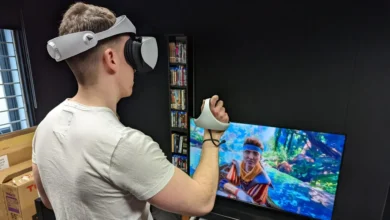Augmented Reality: Applications, Technology, and the Future

Augmented reality (AR) is a transformative technology that overlays digital information and objects onto our real-world environment in real time. AR integrates computer-generated sensory inputs like graphics, video, audio, and GPS data into our field of perception, enhancing our physical surroundings with contextual digital information.
AR technologies have progressed rapidly in the last decade and are poised to become mainstream in consumer and enterprise settings. The global AR market is projected to grow to over $100 billion by 2024. This comprehensive guide examines the fundamentals of augmented reality and its diverse applications across industries.
How Augmented Reality Works
Augmented reality uses a combination of software and hardware components to overlay digital enhancements onto the physical world. Here are the key elements:

Cameras and Sensors
AR devices use cameras, depth sensors, and motion sensors to capture data about the environment, user movements, and positioning.
Software Algorithms
Powerful computer vision algorithms analyze the sensor data to identify reference points and track key features. This enables the anchoring of digital objects.
Displays and Projectors
Optical display technology like smartphone screens or transparent near-eye displays project augmented graphics and information. Some applications use external projectors.
Input Devices
Inputs like touchscreens, handheld controllers, wearables, voice commands, and gesture recognition allow the user to interact with the AR interface.
Object Libraries and 3D Models
AR apps and platforms house expansive databases of pre-designed 3D objects, imagery, and effects that can be integrated into AR scenes.
When these elements come together, they create a comprehensive augmented experience – overlaying graphics, videos, sounds, and other enhancements onto the real environment.
Types of Augmented Reality
There are 3 primary types of augmented reality:
Marker-based AR
Marker-based AR uses identifiable visual markers like QR codes or images to activate and anchor augmented graphics and objects to specific spots in the physical environment. The camera recognizes the marker which triggers the augmented experience.
Location-based AR
Location-based AR leverages GPS data from the user’s device to determine their geographic location and deliver relevant location-specific AR experiences like overlays of historical sites or directional navigation prompts.
Projection-based AR
Projection AR projects synthetic light onto real-world surfaces to create effects like overlapped shadows and textures. For example, projections can transform a plain wall into an interactive augmented display.
Key Components of AR Systems
Robust AR platforms are comprised of specialized hardware and software:
- Sensor
- Cameras
- Accelerometers
- GPS chips
- Depth sensors
- Ambient light sensors
- Input Devices
- Touchscreens
- Voice recognition
- Gesture control
- Eye tracking
- Displays
- Near-eye displays
- Optical projection
- Holographic displays
- Head-up displays
- Smartglasses
- Processing
- Mobile CPUs/GPUs
- Wearable processing units
- Cloud compute resources
- Software
- Operating systems
- SDKs and frameworks
- 3D modeling tools
- Spatial computing engines
Powerful and intuitive AR experiences require optimized combinations of these hardware and software elements.

Key Capabilities of Augmented Reality
Here are some of the unique capabilities enabled by AR technology:
Seamless Integration – AR provides real-time interactivity between the digital and physical in a natural way.
Contextual Data – Relevant data is delivered on-site based on time, location, activities, user identity, and other contextual signals.
Immersive 3D visuals – Photorealistic 3D models and environments can be incorporated to create highly immersive experiences.
Environment analysis – Scanning physical spaces and recognizing objects/surfaces enables contextual interactions.
Annotations and overlays – Information can be anchored on top of real-world objects and environments.
Instruction and guidance – Intuitive step-by-step instructions can guide users through processes in interactive ways.
Simulation – Realistic AR simulations of environments, equipment, and scenarios aid training and design.
Multi-user functionality – AR experiences can be shared between remote users in different locations.
These unique capabilities make AR a versatile platform for creating engaging and innovative applications across industries.
Current Challenges Facing Augmented Reality
While the potential is enormous, AR technology still faces some key challenges:
Hardware limitations – Bulkiness, cost, and limited battery life of headsets along with insufficient processing power restrict mass adoption.
Technical Complexity – Sophisticated AR experiences require expertise in computer vision, 3D graphics, and UX design.
User experience Challenges – Issues like inaccurate tracking, latency, narrow fields of view, and intrusive designs hamper seamless user interactions.
Lack of Standards – Fragmented proprietary platforms and software tools create high development costs.
Privacy Concerns – Collection of data like location, iris scans, and personal spaces raises regulatory issues.
Behavioral Barriers – Lack of education on capabilities and potential benefits slows mainstream adoption.
As the technology matures, many of these challenges will be overcome through iterative hardware improvements, software advancements, and greater standardization.
Augmented Reality Applications
Despite current limitations, AR is already being applied effectively across a diverse array of industries:
Retail and E-commerce
AR allows online shoppers to visualize products in their physical environment before buying. Retailers also use AR for interactive store displays and immersive virtual shopping.
Training and Education
AR delivers interactive 3D learning content and performance support for skills training and instruction across disciplines like engineering, medicine, and design.
Gaming and Entertainment
AR transforms gaming by blending real-world environments into multiplayer gameplay. It also enhances concerts, theme parks, and events with immersive effects.
Travel and Navigation
AR overlays graphical overlays on top of physical surroundings to provide enhanced navigation assistance and location-based recommendations.
Marketing and Advertising
AR allows brands to engage customers with immersive and memorable experiences like augmented packaging, print ads, and interactive storefronts.
Industrial and Manufacturing
AR assists manufacturing and fieldwork through schematic overlays, maintenance instructions, and remote collaboration features.
This diversity of use cases demonstrates how AR can enhance and transform almost any industry and workforce activity through blended physical and digital interactions. The possibilities are endless as technology improves.
The Future of Augmented Reality
Current AR applications represent just the tip of the iceberg. Here are 3 key trends that will shape AR’s future:
Advanced Wearable Devices
Sleeker, more powerful AR smart glasses will enhance immersion and usability. Contact lens displays could make experiences indistinguishable from reality.
Expansion to New Industries
AR will revolutionize fields like healthcare, construction, and automotive with capabilities like remote expert collaboration, precision visualization, and human performance augmentation.
Integrated Enterprise Platforms
End-to-end AR ecosystems with integrated software, cloud services, headset hardware, and applications will enable seamless large-scale business deployment.
With these breakthroughs on the horizon, IDC forecasts that worldwide spending on AR solutions will achieve rapid growth:
- 2020: $12.1 billion
- 2024: $72.8 billion
As hardware, software, connectivity, and content offerings mature, AR has the potential to fundamentally transform how we interact with information and our physical environments across every sector.

Augmented Reality Development Platforms
Here are some of the leading hardware and software options for building AR applications:
Mobile AR Platforms
- ARKit (iOS)
- ARCore (Android)
- Headset Platforms
Microsoft HoloLens
- Magic Leap One
- Oculus for Business
- Cloud Services
Azure Mixed Reality Services
- AR Cloud Anchors (Google)
- Amazon Sumerian
- Game Engines
Unity
- Unreal Engine
- Vuforia Engine
- AR SDKs
Vuforia
- AR Foundation
- EasyAR
- Wikitude
Robust developer communities, detailed documentation, and extensive samples allow both novice and experienced coders to build high-quality AR apps on these platforms.
Getting Started with Augmented Reality Development
For developers interested in exploring AR app creation, here are some tips to get started:
- Learn fundamentals with AR development tutorials for Unity or Android.
- Get familiar with the capabilities of SDKs like Vuforia, ARCore, and ARKit.
- Experiment with sample projects and starter templates for your chosen platform. Remix and build on examples.
- Start simple – create marker-based mini experiences on everyday objects to grasp core principles.
- Explore open-source AR libraries and engines like Spark AR and 8th Wall.
- Get involved in AR developer communities like the AR/VR community on Reddit to learn from peers.
- Examine case studies and listen to talks/podcasts to understand UX and design principles for engaging AR.
- With a structured learning approach, developers from any background can gain the skills needed to start building interactive cross-reality experiences.
Frequently Asked Questions About Augmented Reality
What is the difference between AR and VR?
Augmented reality overlays digital content into the real-world environment while virtual reality is completely immersive and replaces the physical world with a simulated one. AR is additive while VR is transformative.
Does AR require special glasses?
Some AR applications use specialized smart glasses or goggles to enhance the experience. However, many AR apps simply leverage the camera, sensors, and display of consumer smartphones and tablets.
Is AR the same as holograms?
Holographic displays offer a distinct 3D viewing experience, but many people use the term “hologram” loosely to refer to immersive AR/VR content. True holograms are still extremely complex to produce.
Can I create AR apps without coding skills?
Many drag-and-drop AR creation platforms allow novice users to create AR experiences without coding like Adobe Aero, Thyng, and Zapworks. But coding knowledge expands possibilities.
How much does it cost to develop a custom AR app?
Simple AR apps can cost between $10,000 to $30,000+. Enterprise-level apps with complex functionality run from $100,000 to $500,000 or more depending on hardware and labor time.
Is AR used for gaming?
AR gaming that integrates physical environments into multiplayer gameplay is an emerging trend. Popular examples include Pokemon Go, Minecraft Earth, and Harry Potter: Wizards Unite. The AR gaming market is forecasted to surpass $85 billion by 2030.
Can AR be used for remote assistance?
Yes, AR workflows that connect on-site workers with remote experts are being adopted for hands-free visual collaboration in fields like manufacturing, construction, and healthcare.
Is AR used in education?
AR is proven to enable more engaging, interactive learning through 3D models, simulations and immersive content. It has applications across STEM, medicine, history, and more.
What industries will be disrupted by AR?
Industries like retail, tourism, marketing, gaming, logistics, and automotive will see major transformations in business processes and customer experiences due to the unique value AR can provide.
With cameras and sensors now ubiquitous, and smart glasses projected to overcome initial stigma, AR adoption is positioned to enter a period of massive growth over the next decade as hardware, software, and connectivity mature. Possibilities span consumer and enterprise contexts, making augmented reality one of the most promising and transformative technologies on the horizon.





